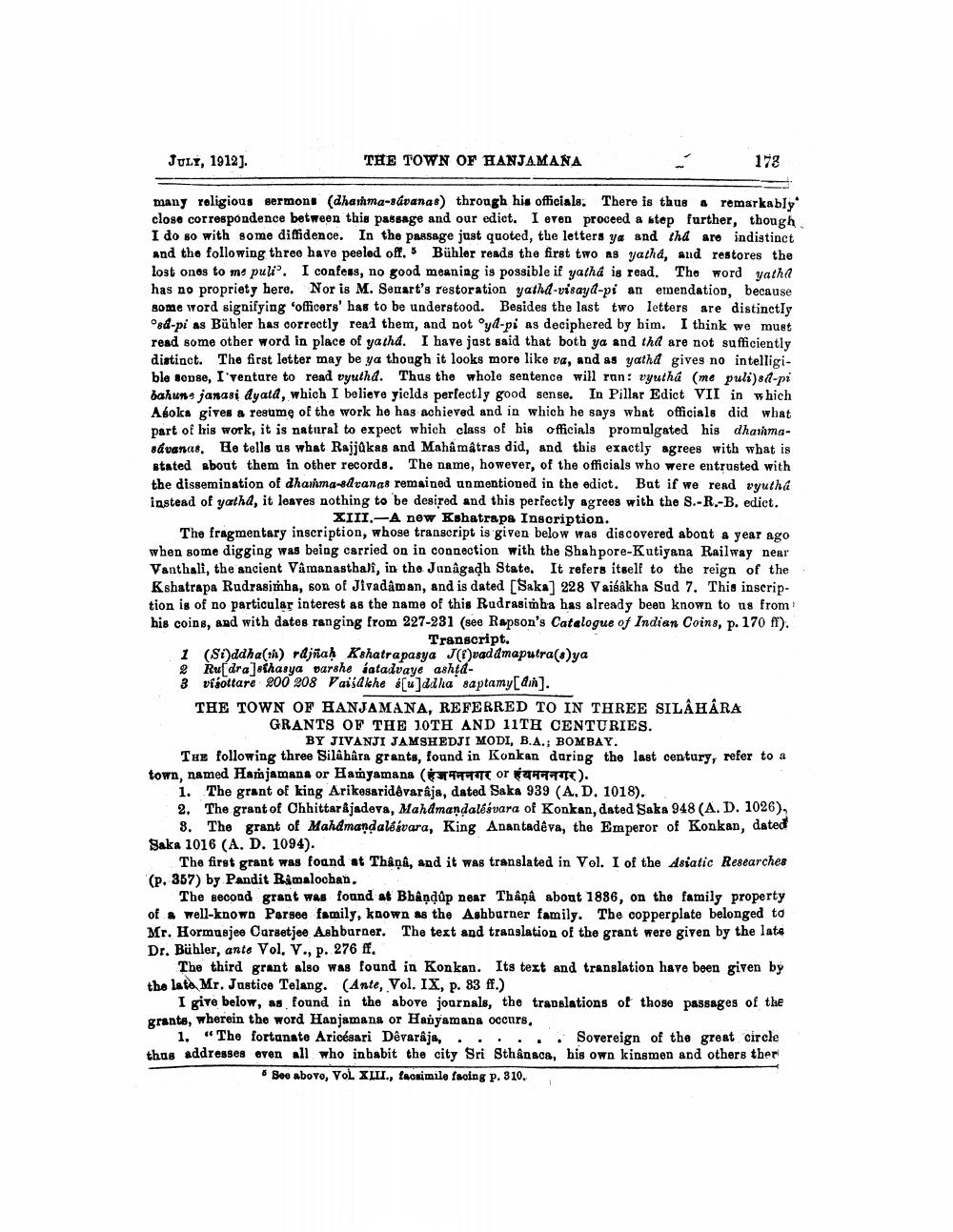________________
JULY, 1912].
many religious sermons (dhamma-sávanas) through his officials. There is thus a remarkably close correspondence between this passage and our edict. I even proceed a step further, though I do so with some diffidence. In the passage just quoted, the letters ya and tha are indistinct and the following three have peeled off. Bühler reads the first two as yathd, and restores the lost ones to me puli. I confess, no good meaning is possible if yatha is read. The word yatha has no propriety here. Nor is M. Senart's restoration gatha-visayd-pi an emendation, because some word signifying 'officers' has to be understood. Besides the last two letters are distinctly sd-pi as Bühler has correctly read them, and not °yd-pi as deciphered by him. I think we must read some other word in place of yathd. I have just said that both ya and tha are not sufficiently distinct. The first letter may be ya though it looks more like va, and as yatha gives no intelligible sense, I'venture to read vyutha. Thus the whole sentence will ran: vyutha (me puli)sa-pi bahune janasi dyata, which I believe yields perfectly good sense. In Pillar Edict VII in which Asoka gives a resume of the work he has achieved and in which he says what officials did what part of his work, it is natural to expect which class of his officials promulgated his dhammasávanas. He tells us what Rajjûkas and Mahâmâtras did, and this exactly agrees with what is stated about them in other records. The name, however, of the officials who were entrusted with the dissemination of dhamma-savanas remained unmentioned in the edict. But if we read vyutha instead of yatha, it leaves nothing to be desired and this perfectly agrees with the S.-R.-B. edict. XIII. A new Kshatrapa Inscription.
The fragmentary inscription, whose transcript is given below was discovered about a year ago when some digging was being carried on in connection with the Shahpore-Kutiyana Railway near Vanthali, the ancient Vâmanasthali, in the Junagadh State. It refers itself to the reign of the Kshatrapa Rudrasimha, son of Jivadaman, and is dated [Saka] 228 Vaisakha Sud 7. This inscription is of no particular interest as the name of this Rudrasimha has already been known to us from his coins, and with dates ranging from 227-231 (see Rapson's Catalogue of Indian Coins, p. 170 ff). Transcript.
THE TOWN OF HANJAMANA
1 (Si)ddha(th) rajñaḥ Kshatrapasya Ji)vadamaputra(s)ya 2 Rudra]sihasya varshe satadvaye ashta
3 visottare 200 208 Vaisakhe [u]ddha saptamy [an].
178
THE TOWN OF HANJAMANA, REFERRED TO IN THREE SILAHARA
GRANTS OF THE 10TH AND 11TH CENTURIES. BY JIVANJI JAMSHEDJI MODI, B.A.; BOMBAY.
THE following three Silâhâra grants, found in Konkan daring the last century, refer to a town, named Harjamana or Hanyamana (हंजमननगर or हंयमननगर ).
1. The grant of king Arikesaridêvarâja, dated Saka 939 (A. D. 1018).
2. The grant of Chhittarajadeva, Mahamandalésvara of Konkan, dated Saka 948 (A. D. 1026), 8. The grant of Mahamandalésvara, King Anantadêva, the Emperor of Konkan, dated Saka 1016 (A. D. 1094).
The first grant was found at Thânâ, and it was translated in Vol. I of the Asiatic Researches (p. 357) by Pandit Ramalochan.
The second grant was found at Bhandup near Thânâ about 1886, on the family property of a well-known Parsee family, known as the Ashburner family. The copperplate belonged to Mr. Hormusjee Carsetjee Ashburner. The text and translation of the grant were given by the late Dr. Bühler, ante Vol. V., p. 276 ff.
The third grant also was found in Konkan. Its text and translation have been given by the late Mr. Justice Telang. (Ante, Vol. IX, p. 33 ff.)
I give below, as found in the above journals, the translations of those passages of the grants, wherein the word Hanjamana or Hanyamana occurs.
1. "The fortunate Aricésari Dêvarâja,
Sovereign of the great circle thus addresses even all who inhabit the city Sri Sthânaca, his own kinsmen and others ther
5 See above, Vol. XIII., facsimile facing p. 310.




